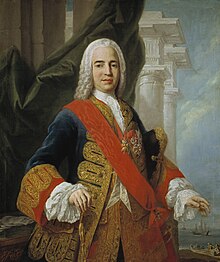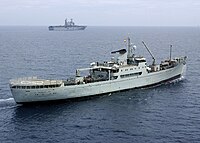Arsenal de la Carraca
| La Carraca Naval Station | |
|---|---|
Arsenal de La Carraca | |
Antonio Valdes | |
| Garrison information | |
| Current commander | Rear admiral Alfonso Gómez Fernández de Córdoba[1] |
| Occupants | See Ships |

Arsenal de la Carraca, also Naval Station of La Carraca, is a naval shipyard and a naval base in
Geography
The
History

The island was used for Spanish naval operations from 1655. The arsenal was established early on around the wreck of an old
Even before the formal decree was issued, construction work started around 1720, and by 1733 the main entrance to the San Fernando quay was built. Shipbuilding activities commenced in 1736. By the end of first half of the 18th century, docks, warehouses, offices, workshops and homes had been built. Even though
The naval complex had facilities for ship building, equipping, and repair. In addition to the docks built between 1784 and 1788, one more was added in the 19th century, all remaining in operation until recent years.
Architecture and fittings
The arsenal's urban plan included the four docks, a patent slip, building slips,[4] the Carrack Church, the Prison of the Four Towers (where Francisco de Miranda was imprisoned and died in 1816), workshops, dams and docks. The three defensive batteries of San Fernando, San Ramon Battery, and Santa Rosa, were each equipped with 11 guns.
Ships

- Transport ships.
- Contramaestre Casado (A-01)
- Training ships.
- Juan Sebastián Elcano (A-71)
References
- ^ Toma de posesión del Almirante Segundo Jefe del Arsenal de Cádiz
- ^ Quintero González, J. The Arsenal Ratchet (1717-1736). Ed Ministry of Defence, Madrid. 2000
- ^ a b c d e "Arsenal De La Carraca" (in Spanish). Lucense.galeon.com. Archived from the original on 11 July 2011. Retrieved 18 January 2013.
- ^ a b United States. Hydrographic Office (1920). East Atlantic pilot: The coast of Spain and Portugal from Cape Toriñana to Cape Trafalgar, the Madeira group, Azores or Western Islands, Canary Islands, Cape Verde Islands, and the west coast of Africa from Cape Spartel to Cape Palmas (Public domain ed.). Government Printing Office. pp. 201–. Retrieved 19 January 2013.
- ^ a b "Arsenal de la Carraca, San Fernando" (in Spanish). Official Website of Tourism organization of Andalucia.org. Retrieved 18 January 2013.
- ISBN 978-0-7546-6109-2. Retrieved 3 January 2013.
- ISBN 0-7603-1345-8
- ^ Murray Fraser Sueter (1907). The evolution of the submarine boat, mine and torpedo, from the sixteenth century to the present time. J. Griffin and Co. Retrieved 3 January 2013.
External links
![]() Media related to Arsenal de la Carraca at Wikimedia Commons
Media related to Arsenal de la Carraca at Wikimedia Commons
